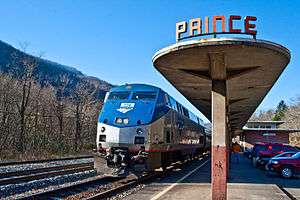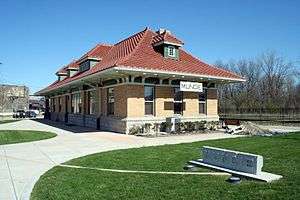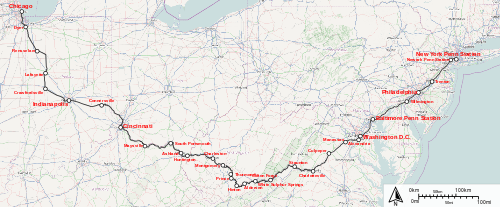Cardinal (train)
 Eastbound Cardinal stopped in Prince, West Virginia | ||||||||||||||||||||||||||||||||||||||||||||||||||||||||||||||||||||||||||||||||||||||||||||||||||||||||||||||||||||||||||||||||||||||||||||||||||||||||||||||||||||||||||||||||||||||||||||||||||||||||||||||||||||||||||||||||||||||||||||||||||||||||||||||||||||||||||||||||||||||||||||||||||||||||||||||||||||||||||||||||||||||||||||||||||||||||||||||||||||||||||||||||||||||||||||||||||||||||||||||||||||||||||||||||||||||||||||||||||||||||||||||||||||||||||||||||||||||||||||||||||||||||||||||||||||||||||||||||||||||||||||||||||||
| Overview | ||||||||||||||||||||||||||||||||||||||||||||||||||||||||||||||||||||||||||||||||||||||||||||||||||||||||||||||||||||||||||||||||||||||||||||||||||||||||||||||||||||||||||||||||||||||||||||||||||||||||||||||||||||||||||||||||||||||||||||||||||||||||||||||||||||||||||||||||||||||||||||||||||||||||||||||||||||||||||||||||||||||||||||||||||||||||||||||||||||||||||||||||||||||||||||||||||||||||||||||||||||||||||||||||||||||||||||||||||||||||||||||||||||||||||||||||||||||||||||||||||||||||||||||||||||||||||||||||||||||||||||||||||||
|---|---|---|---|---|---|---|---|---|---|---|---|---|---|---|---|---|---|---|---|---|---|---|---|---|---|---|---|---|---|---|---|---|---|---|---|---|---|---|---|---|---|---|---|---|---|---|---|---|---|---|---|---|---|---|---|---|---|---|---|---|---|---|---|---|---|---|---|---|---|---|---|---|---|---|---|---|---|---|---|---|---|---|---|---|---|---|---|---|---|---|---|---|---|---|---|---|---|---|---|---|---|---|---|---|---|---|---|---|---|---|---|---|---|---|---|---|---|---|---|---|---|---|---|---|---|---|---|---|---|---|---|---|---|---|---|---|---|---|---|---|---|---|---|---|---|---|---|---|---|---|---|---|---|---|---|---|---|---|---|---|---|---|---|---|---|---|---|---|---|---|---|---|---|---|---|---|---|---|---|---|---|---|---|---|---|---|---|---|---|---|---|---|---|---|---|---|---|---|---|---|---|---|---|---|---|---|---|---|---|---|---|---|---|---|---|---|---|---|---|---|---|---|---|---|---|---|---|---|---|---|---|---|---|---|---|---|---|---|---|---|---|---|---|---|---|---|---|---|---|---|---|---|---|---|---|---|---|---|---|---|---|---|---|---|---|---|---|---|---|---|---|---|---|---|---|---|---|---|---|---|---|---|---|---|---|---|---|---|---|---|---|---|---|---|---|---|---|---|---|---|---|---|---|---|---|---|---|---|---|---|---|---|---|---|---|---|---|---|---|---|---|---|---|---|---|---|---|---|---|---|---|---|---|---|---|---|---|---|---|---|---|---|---|---|---|---|---|---|---|---|---|---|---|---|---|---|---|---|---|---|---|---|---|---|---|---|---|---|---|---|---|---|---|---|---|---|---|---|---|---|---|---|---|---|---|---|---|---|---|---|---|---|---|---|---|---|---|---|---|---|---|---|---|---|---|---|---|---|---|---|---|---|---|---|---|---|---|---|---|---|---|---|---|---|---|---|---|---|---|---|---|---|---|---|---|---|---|---|---|---|---|---|---|---|---|---|---|---|---|---|---|---|---|---|---|---|---|---|---|---|---|---|---|---|---|---|---|---|---|---|---|---|---|---|---|---|---|---|---|---|---|---|---|---|---|---|---|---|---|---|---|---|---|---|---|---|---|---|---|---|---|---|---|---|---|---|---|---|---|---|---|---|---|---|---|---|---|---|---|---|---|---|---|---|---|---|---|---|---|---|---|---|
| Service type |
Inter-city rail Higher speed rail (Northeast Corridor only-currently suspended) | |||||||||||||||||||||||||||||||||||||||||||||||||||||||||||||||||||||||||||||||||||||||||||||||||||||||||||||||||||||||||||||||||||||||||||||||||||||||||||||||||||||||||||||||||||||||||||||||||||||||||||||||||||||||||||||||||||||||||||||||||||||||||||||||||||||||||||||||||||||||||||||||||||||||||||||||||||||||||||||||||||||||||||||||||||||||||||||||||||||||||||||||||||||||||||||||||||||||||||||||||||||||||||||||||||||||||||||||||||||||||||||||||||||||||||||||||||||||||||||||||||||||||||||||||||||||||||||||||||||||||||||||||||
| Status | Operating | |||||||||||||||||||||||||||||||||||||||||||||||||||||||||||||||||||||||||||||||||||||||||||||||||||||||||||||||||||||||||||||||||||||||||||||||||||||||||||||||||||||||||||||||||||||||||||||||||||||||||||||||||||||||||||||||||||||||||||||||||||||||||||||||||||||||||||||||||||||||||||||||||||||||||||||||||||||||||||||||||||||||||||||||||||||||||||||||||||||||||||||||||||||||||||||||||||||||||||||||||||||||||||||||||||||||||||||||||||||||||||||||||||||||||||||||||||||||||||||||||||||||||||||||||||||||||||||||||||||||||||||||||||
| Locale |
Midwestern United States Southeastern United States Mid-Atlantic states | |||||||||||||||||||||||||||||||||||||||||||||||||||||||||||||||||||||||||||||||||||||||||||||||||||||||||||||||||||||||||||||||||||||||||||||||||||||||||||||||||||||||||||||||||||||||||||||||||||||||||||||||||||||||||||||||||||||||||||||||||||||||||||||||||||||||||||||||||||||||||||||||||||||||||||||||||||||||||||||||||||||||||||||||||||||||||||||||||||||||||||||||||||||||||||||||||||||||||||||||||||||||||||||||||||||||||||||||||||||||||||||||||||||||||||||||||||||||||||||||||||||||||||||||||||||||||||||||||||||||||||||||||||
| Predecessor | James Whitcomb Riley | |||||||||||||||||||||||||||||||||||||||||||||||||||||||||||||||||||||||||||||||||||||||||||||||||||||||||||||||||||||||||||||||||||||||||||||||||||||||||||||||||||||||||||||||||||||||||||||||||||||||||||||||||||||||||||||||||||||||||||||||||||||||||||||||||||||||||||||||||||||||||||||||||||||||||||||||||||||||||||||||||||||||||||||||||||||||||||||||||||||||||||||||||||||||||||||||||||||||||||||||||||||||||||||||||||||||||||||||||||||||||||||||||||||||||||||||||||||||||||||||||||||||||||||||||||||||||||||||||||||||||||||||||||
| First service | October 30, 1977 | |||||||||||||||||||||||||||||||||||||||||||||||||||||||||||||||||||||||||||||||||||||||||||||||||||||||||||||||||||||||||||||||||||||||||||||||||||||||||||||||||||||||||||||||||||||||||||||||||||||||||||||||||||||||||||||||||||||||||||||||||||||||||||||||||||||||||||||||||||||||||||||||||||||||||||||||||||||||||||||||||||||||||||||||||||||||||||||||||||||||||||||||||||||||||||||||||||||||||||||||||||||||||||||||||||||||||||||||||||||||||||||||||||||||||||||||||||||||||||||||||||||||||||||||||||||||||||||||||||||||||||||||||||
| Successor | None | |||||||||||||||||||||||||||||||||||||||||||||||||||||||||||||||||||||||||||||||||||||||||||||||||||||||||||||||||||||||||||||||||||||||||||||||||||||||||||||||||||||||||||||||||||||||||||||||||||||||||||||||||||||||||||||||||||||||||||||||||||||||||||||||||||||||||||||||||||||||||||||||||||||||||||||||||||||||||||||||||||||||||||||||||||||||||||||||||||||||||||||||||||||||||||||||||||||||||||||||||||||||||||||||||||||||||||||||||||||||||||||||||||||||||||||||||||||||||||||||||||||||||||||||||||||||||||||||||||||||||||||||||||
| Current operator(s) | Amtrak | |||||||||||||||||||||||||||||||||||||||||||||||||||||||||||||||||||||||||||||||||||||||||||||||||||||||||||||||||||||||||||||||||||||||||||||||||||||||||||||||||||||||||||||||||||||||||||||||||||||||||||||||||||||||||||||||||||||||||||||||||||||||||||||||||||||||||||||||||||||||||||||||||||||||||||||||||||||||||||||||||||||||||||||||||||||||||||||||||||||||||||||||||||||||||||||||||||||||||||||||||||||||||||||||||||||||||||||||||||||||||||||||||||||||||||||||||||||||||||||||||||||||||||||||||||||||||||||||||||||||||||||||||||
| Ridership | 113,103 total (FY13) | |||||||||||||||||||||||||||||||||||||||||||||||||||||||||||||||||||||||||||||||||||||||||||||||||||||||||||||||||||||||||||||||||||||||||||||||||||||||||||||||||||||||||||||||||||||||||||||||||||||||||||||||||||||||||||||||||||||||||||||||||||||||||||||||||||||||||||||||||||||||||||||||||||||||||||||||||||||||||||||||||||||||||||||||||||||||||||||||||||||||||||||||||||||||||||||||||||||||||||||||||||||||||||||||||||||||||||||||||||||||||||||||||||||||||||||||||||||||||||||||||||||||||||||||||||||||||||||||||||||||||||||||||||
| Route | ||||||||||||||||||||||||||||||||||||||||||||||||||||||||||||||||||||||||||||||||||||||||||||||||||||||||||||||||||||||||||||||||||||||||||||||||||||||||||||||||||||||||||||||||||||||||||||||||||||||||||||||||||||||||||||||||||||||||||||||||||||||||||||||||||||||||||||||||||||||||||||||||||||||||||||||||||||||||||||||||||||||||||||||||||||||||||||||||||||||||||||||||||||||||||||||||||||||||||||||||||||||||||||||||||||||||||||||||||||||||||||||||||||||||||||||||||||||||||||||||||||||||||||||||||||||||||||||||||||||||||||||||||||
| Start | Chicago, Illinois | |||||||||||||||||||||||||||||||||||||||||||||||||||||||||||||||||||||||||||||||||||||||||||||||||||||||||||||||||||||||||||||||||||||||||||||||||||||||||||||||||||||||||||||||||||||||||||||||||||||||||||||||||||||||||||||||||||||||||||||||||||||||||||||||||||||||||||||||||||||||||||||||||||||||||||||||||||||||||||||||||||||||||||||||||||||||||||||||||||||||||||||||||||||||||||||||||||||||||||||||||||||||||||||||||||||||||||||||||||||||||||||||||||||||||||||||||||||||||||||||||||||||||||||||||||||||||||||||||||||||||||||||||||
| Stops |
36 (from New York City) 30 (from Washington, D.C.) | |||||||||||||||||||||||||||||||||||||||||||||||||||||||||||||||||||||||||||||||||||||||||||||||||||||||||||||||||||||||||||||||||||||||||||||||||||||||||||||||||||||||||||||||||||||||||||||||||||||||||||||||||||||||||||||||||||||||||||||||||||||||||||||||||||||||||||||||||||||||||||||||||||||||||||||||||||||||||||||||||||||||||||||||||||||||||||||||||||||||||||||||||||||||||||||||||||||||||||||||||||||||||||||||||||||||||||||||||||||||||||||||||||||||||||||||||||||||||||||||||||||||||||||||||||||||||||||||||||||||||||||||||||
| End |
New York City Washington, D.C. (temporary terminus since March 29, 2018)[1] | |||||||||||||||||||||||||||||||||||||||||||||||||||||||||||||||||||||||||||||||||||||||||||||||||||||||||||||||||||||||||||||||||||||||||||||||||||||||||||||||||||||||||||||||||||||||||||||||||||||||||||||||||||||||||||||||||||||||||||||||||||||||||||||||||||||||||||||||||||||||||||||||||||||||||||||||||||||||||||||||||||||||||||||||||||||||||||||||||||||||||||||||||||||||||||||||||||||||||||||||||||||||||||||||||||||||||||||||||||||||||||||||||||||||||||||||||||||||||||||||||||||||||||||||||||||||||||||||||||||||||||||||||||
| Distance travelled |
1,146 miles (1,844 km)(from New York City) 922 miles (1,484 km)(from Washington, D.C.) | |||||||||||||||||||||||||||||||||||||||||||||||||||||||||||||||||||||||||||||||||||||||||||||||||||||||||||||||||||||||||||||||||||||||||||||||||||||||||||||||||||||||||||||||||||||||||||||||||||||||||||||||||||||||||||||||||||||||||||||||||||||||||||||||||||||||||||||||||||||||||||||||||||||||||||||||||||||||||||||||||||||||||||||||||||||||||||||||||||||||||||||||||||||||||||||||||||||||||||||||||||||||||||||||||||||||||||||||||||||||||||||||||||||||||||||||||||||||||||||||||||||||||||||||||||||||||||||||||||||||||||||||||||
| Average journey time | 28 hours | |||||||||||||||||||||||||||||||||||||||||||||||||||||||||||||||||||||||||||||||||||||||||||||||||||||||||||||||||||||||||||||||||||||||||||||||||||||||||||||||||||||||||||||||||||||||||||||||||||||||||||||||||||||||||||||||||||||||||||||||||||||||||||||||||||||||||||||||||||||||||||||||||||||||||||||||||||||||||||||||||||||||||||||||||||||||||||||||||||||||||||||||||||||||||||||||||||||||||||||||||||||||||||||||||||||||||||||||||||||||||||||||||||||||||||||||||||||||||||||||||||||||||||||||||||||||||||||||||||||||||||||||||||
| Service frequency | Thrice-weekly | |||||||||||||||||||||||||||||||||||||||||||||||||||||||||||||||||||||||||||||||||||||||||||||||||||||||||||||||||||||||||||||||||||||||||||||||||||||||||||||||||||||||||||||||||||||||||||||||||||||||||||||||||||||||||||||||||||||||||||||||||||||||||||||||||||||||||||||||||||||||||||||||||||||||||||||||||||||||||||||||||||||||||||||||||||||||||||||||||||||||||||||||||||||||||||||||||||||||||||||||||||||||||||||||||||||||||||||||||||||||||||||||||||||||||||||||||||||||||||||||||||||||||||||||||||||||||||||||||||||||||||||||||||
| Train number(s) | 50/51 | |||||||||||||||||||||||||||||||||||||||||||||||||||||||||||||||||||||||||||||||||||||||||||||||||||||||||||||||||||||||||||||||||||||||||||||||||||||||||||||||||||||||||||||||||||||||||||||||||||||||||||||||||||||||||||||||||||||||||||||||||||||||||||||||||||||||||||||||||||||||||||||||||||||||||||||||||||||||||||||||||||||||||||||||||||||||||||||||||||||||||||||||||||||||||||||||||||||||||||||||||||||||||||||||||||||||||||||||||||||||||||||||||||||||||||||||||||||||||||||||||||||||||||||||||||||||||||||||||||||||||||||||||||
| On-board services | ||||||||||||||||||||||||||||||||||||||||||||||||||||||||||||||||||||||||||||||||||||||||||||||||||||||||||||||||||||||||||||||||||||||||||||||||||||||||||||||||||||||||||||||||||||||||||||||||||||||||||||||||||||||||||||||||||||||||||||||||||||||||||||||||||||||||||||||||||||||||||||||||||||||||||||||||||||||||||||||||||||||||||||||||||||||||||||||||||||||||||||||||||||||||||||||||||||||||||||||||||||||||||||||||||||||||||||||||||||||||||||||||||||||||||||||||||||||||||||||||||||||||||||||||||||||||||||||||||||||||||||||||||||
| Class(es) |
| |||||||||||||||||||||||||||||||||||||||||||||||||||||||||||||||||||||||||||||||||||||||||||||||||||||||||||||||||||||||||||||||||||||||||||||||||||||||||||||||||||||||||||||||||||||||||||||||||||||||||||||||||||||||||||||||||||||||||||||||||||||||||||||||||||||||||||||||||||||||||||||||||||||||||||||||||||||||||||||||||||||||||||||||||||||||||||||||||||||||||||||||||||||||||||||||||||||||||||||||||||||||||||||||||||||||||||||||||||||||||||||||||||||||||||||||||||||||||||||||||||||||||||||||||||||||||||||||||||||||||||||||||||
| Seating arrangements | Airline-style | |||||||||||||||||||||||||||||||||||||||||||||||||||||||||||||||||||||||||||||||||||||||||||||||||||||||||||||||||||||||||||||||||||||||||||||||||||||||||||||||||||||||||||||||||||||||||||||||||||||||||||||||||||||||||||||||||||||||||||||||||||||||||||||||||||||||||||||||||||||||||||||||||||||||||||||||||||||||||||||||||||||||||||||||||||||||||||||||||||||||||||||||||||||||||||||||||||||||||||||||||||||||||||||||||||||||||||||||||||||||||||||||||||||||||||||||||||||||||||||||||||||||||||||||||||||||||||||||||||||||||||||||||||
| Sleeping arrangements |
Viewliner Roomette (2 beds) Viewliner Bedroom (2 beds) Viewliner Bedroom Suite (4 beds) Viewliner Accessible Bedroom (2 beds) | |||||||||||||||||||||||||||||||||||||||||||||||||||||||||||||||||||||||||||||||||||||||||||||||||||||||||||||||||||||||||||||||||||||||||||||||||||||||||||||||||||||||||||||||||||||||||||||||||||||||||||||||||||||||||||||||||||||||||||||||||||||||||||||||||||||||||||||||||||||||||||||||||||||||||||||||||||||||||||||||||||||||||||||||||||||||||||||||||||||||||||||||||||||||||||||||||||||||||||||||||||||||||||||||||||||||||||||||||||||||||||||||||||||||||||||||||||||||||||||||||||||||||||||||||||||||||||||||||||||||||||||||||||
| Catering facilities | Dining car and on-board café | |||||||||||||||||||||||||||||||||||||||||||||||||||||||||||||||||||||||||||||||||||||||||||||||||||||||||||||||||||||||||||||||||||||||||||||||||||||||||||||||||||||||||||||||||||||||||||||||||||||||||||||||||||||||||||||||||||||||||||||||||||||||||||||||||||||||||||||||||||||||||||||||||||||||||||||||||||||||||||||||||||||||||||||||||||||||||||||||||||||||||||||||||||||||||||||||||||||||||||||||||||||||||||||||||||||||||||||||||||||||||||||||||||||||||||||||||||||||||||||||||||||||||||||||||||||||||||||||||||||||||||||||||||
| Baggage facilities | Checked baggage available at selected stations | |||||||||||||||||||||||||||||||||||||||||||||||||||||||||||||||||||||||||||||||||||||||||||||||||||||||||||||||||||||||||||||||||||||||||||||||||||||||||||||||||||||||||||||||||||||||||||||||||||||||||||||||||||||||||||||||||||||||||||||||||||||||||||||||||||||||||||||||||||||||||||||||||||||||||||||||||||||||||||||||||||||||||||||||||||||||||||||||||||||||||||||||||||||||||||||||||||||||||||||||||||||||||||||||||||||||||||||||||||||||||||||||||||||||||||||||||||||||||||||||||||||||||||||||||||||||||||||||||||||||||||||||||||
| Technical | ||||||||||||||||||||||||||||||||||||||||||||||||||||||||||||||||||||||||||||||||||||||||||||||||||||||||||||||||||||||||||||||||||||||||||||||||||||||||||||||||||||||||||||||||||||||||||||||||||||||||||||||||||||||||||||||||||||||||||||||||||||||||||||||||||||||||||||||||||||||||||||||||||||||||||||||||||||||||||||||||||||||||||||||||||||||||||||||||||||||||||||||||||||||||||||||||||||||||||||||||||||||||||||||||||||||||||||||||||||||||||||||||||||||||||||||||||||||||||||||||||||||||||||||||||||||||||||||||||||||||||||||||||||
| Rolling stock | ||||||||||||||||||||||||||||||||||||||||||||||||||||||||||||||||||||||||||||||||||||||||||||||||||||||||||||||||||||||||||||||||||||||||||||||||||||||||||||||||||||||||||||||||||||||||||||||||||||||||||||||||||||||||||||||||||||||||||||||||||||||||||||||||||||||||||||||||||||||||||||||||||||||||||||||||||||||||||||||||||||||||||||||||||||||||||||||||||||||||||||||||||||||||||||||||||||||||||||||||||||||||||||||||||||||||||||||||||||||||||||||||||||||||||||||||||||||||||||||||||||||||||||||||||||||||||||||||||||||||||||||||||||
| Track gauge | 4 ft 8 1⁄2 in (1,435 mm) standard gauge | |||||||||||||||||||||||||||||||||||||||||||||||||||||||||||||||||||||||||||||||||||||||||||||||||||||||||||||||||||||||||||||||||||||||||||||||||||||||||||||||||||||||||||||||||||||||||||||||||||||||||||||||||||||||||||||||||||||||||||||||||||||||||||||||||||||||||||||||||||||||||||||||||||||||||||||||||||||||||||||||||||||||||||||||||||||||||||||||||||||||||||||||||||||||||||||||||||||||||||||||||||||||||||||||||||||||||||||||||||||||||||||||||||||||||||||||||||||||||||||||||||||||||||||||||||||||||||||||||||||||||||||||||||
| Track owner(s) |
Amtrak CSX Transportation Buckingham Branch NS Railway CN Railway Union Pacific Metra | |||||||||||||||||||||||||||||||||||||||||||||||||||||||||||||||||||||||||||||||||||||||||||||||||||||||||||||||||||||||||||||||||||||||||||||||||||||||||||||||||||||||||||||||||||||||||||||||||||||||||||||||||||||||||||||||||||||||||||||||||||||||||||||||||||||||||||||||||||||||||||||||||||||||||||||||||||||||||||||||||||||||||||||||||||||||||||||||||||||||||||||||||||||||||||||||||||||||||||||||||||||||||||||||||||||||||||||||||||||||||||||||||||||||||||||||||||||||||||||||||||||||||||||||||||||||||||||||||||||||||||||||||||
| ||||||||||||||||||||||||||||||||||||||||||||||||||||||||||||||||||||||||||||||||||||||||||||||||||||||||||||||||||||||||||||||||||||||||||||||||||||||||||||||||||||||||||||||||||||||||||||||||||||||||||||||||||||||||||||||||||||||||||||||||||||||||||||||||||||||||||||||||||||||||||||||||||||||||||||||||||||||||||||||||||||||||||||||||||||||||||||||||||||||||||||||||||||||||||||||||||||||||||||||||||||||||||||||||||||||||||||||||||||||||||||||||||||||||||||||||||||||||||||||||||||||||||||||||||||||||||||||||||||||||||||||||||||
The Cardinal is a thrice-weekly long distance passenger train operated by Amtrak between New York Penn Station (temporarily from Washington Union Station since March 29, 2018)[1] and Chicago Union Station, with major intermediate stops at Philadelphia (temporarily suspended), Washington, D.C., Charlottesville, Charleston, Huntington, Cincinnati, and Indianapolis.
Trains depart New York City (temporarily from Washington, D.C. since March 29, 2018) on Sundays, Wednesdays, and Fridays, and depart Chicago on Tuesdays, Thursdays, and Saturdays. The 1,146-mile (1,844 km) trip between Chicago and New York City (922-mile (1,484 km) with its temporary origin of Washington, D.C.) takes 281⁄4 hours, and 24 hours along its temporarily shortened route.[2]
The Hoosier State provides service on the 196-mile (315 km) segment of the Cardinal route between Indianapolis and Chicago on the four days of the week when it is not otherwise provided by the Cardinal.[2]
During fiscal year 2016-2017, the Cardinal carried 112,432 passengers,[3] up 7.25% from fiscal year 2015-2016. Overall, Amtrak recorded 31.7 million passenger trips in 2016-2017, an increase of 1.5% over the previous year, with total revenue of $3.2 billion, up 1.1% over the same time period.[3]
The Cardinal brings in approximately $7-8 Million per year in ticket revenue, most recent figures show revenue of $7,658,608 in fiscal year 2015-2016, relatively unchanged from the five years prior.[4]
History
The Cardinal is the successor of several previous trains, primarily the New York Central (later Penn Central) James Whitcomb Riley and the Chesapeake and Ohio Railway (C&O) George Washington. The James Whitcomb Riley was a daytime all-coach train which operated between Chicago and Cincinnati (via Indianapolis), while the George Washington was a C&O sleeper that ran between Cincinnati, Washington, D.C., and Newport News, Virginia. Up until the late 1950s, the Riley would carry the Washington's sleeper cars between Cincinnati and Chicago.[5] Both routes survived until the formation of Amtrak in 1971.[6]:51; 93
Amtrak kept service mostly identical at first.[7] Through Washington–Chicago and Newport News–Chicago coaches began operating July 12, and a through sleeping car began September 8.[8] On May 19, 1974, Amtrak merged the George Washington with the Riley, forming a single long-distance route that ran from Chicago to Washington.
Earlier in 1974, Amtrak had rerouted the Riley off the rapidly deteriorating Penn Central track in Indiana.[8] The Newport News section ended in 1976, replaced by the New York–Newport News Colonial.[9]

The James Whitcomb Riley was renamed the Cardinal on October 30, 1977, as the Cardinal was the state bird of all six states through which it ran. However, due to poor track conditions in Indiana, the train was rerouted numerous times, first over various Penn Central/Conrail routings, then ultimately over the former Baltimore and Ohio route via Cottage Grove by 1980.[10]
The Cardinal was eventually extended from Washington, D.C., to New York City in an effort to improve the Cardinal's cost recovery ratio, but the entire train was discontinued on September 30, 1981. A congressional mandate initiated by Senator Robert C. Byrd (D-WV) resurrected the train on January 8, 1982, and followed another new route, via Richmond, Indiana, and Muncie, Indiana. This arrangement lasted until April 27, 1986, when the train was finally moved to its current route via Indianapolis.[10] On October 29, 1995, the Cardinal was truncated at Washington, D.C. as a result of the conversion to Superliner equipment. On October 27, 2002, issues with derailments caused the Cardinal's Superliner equipment to be taken away. They were replaced with Viewliner equipment. The Cardinal continued to operate the Chicago-Washington D.C. schedule. Service to New York was restored on Sunday's westbound Cardinal on October 27, 2003. Full service to New York resumed on April 26, 2004.
On March 10, 2018, Amtrak announced that, due to continuing construction on the Northeast Corridor, the Cardinal's eastern terminus would temporarily move from Penn Station in New York City to Union Station in Washington, D.C. In addition, all service on the Cardinal between Washington, D.C. and New York City will be temporarily suspended. This change went into effect on March 29, 2018 and will remain in effect until further notice. Cardinal passengers traveling on toward Baltimore, Maryland; Philadelphia, Pennsylvania and New York City will be required to transfer to already existing Northeast Regional or Acela Express trains in Washington. Conversely, Northeast Corridor passengers ticketed to the Cardinal will be required to first travel to Washington aboard existing Northeast Regional or Acela Express trains before transferring to the Cardinal.[1]
Hoosier State
With the Indianapolis routing, the Cardinal began operating jointly with the Chicago–Indianapolis Hoosier State. The Hoosier State operated to Indianapolis on the days the Cardinal does not. This pattern ceased on October 25, 1987, then resumed again on July 19, 1998. On December 17, 1999, Amtrak extended the Hoosier State to Jeffersonville, Indiana, (and later to Louisville, Kentucky) and renamed the train the Kentucky Cardinal. This new train was a daily service; on days when the Cardinal operated, the two trains ran combined between Indianapolis and Chicago. Amtrak ultimately discontinued the Kentucky Cardinal on July 4, 2003.
Plans
In the July 2010 issue of Trains magazine, the Cardinal was noted as being one of five routes under consideration for performance improvement.[11] For the Cardinal, the proposed changes include:
In addition, Railfan and Railroad magazine suggested that the train be rerouted to St. Louis as well, with a separate section bound for Chicago.
In early October 2010, Amtrak released a report detailing plans to increase the Cardinal's service from three trains a week to daily service, as well as increasing the train's on-time performance and food service.[12] The January 2011 issue of Trains later revealed that Amtrak would scrap re-routing and Superliner conversion and instead adopt not only daily service, but also purchasing dome cars to be used along the Chicago-Washington, D.C., portion of the trip. In addition, the routing into Chicago Union Station would be changed and station platforms along the route containing coal dust would be scrubbed and cleaned.[13]
However, obstacles to a daily Cardinal persist. Track capacity is limited on the Buckingham Branch Railroad in Virginia where the Cardinal operates, preventing frequent freight trains from passing a daily Cardinal. This problem applies also to the planned but failed Greenbrier Presidential Express train, which would also have traversed the Buckingham Branch on a weekly basis. The Buckingham Branch requires additional funding to expand several sidings before allowing additional service.[14] Another obstacle is freight congestion in Chicago particularly at the 75th Street Corridor in Chicago's South Side.[15] Infrastructure improvements are being made at both obstacles. The Orange Branch between Orange and Gordonsville raised train speed after the completion of a track and signal project in 2017.[16] The Chicago Region Environmental and Transportation Efficiency Program (CREATE) has completed a preliminary design phase for the 75th Street Corridor and is awaiting funding for Phase 2.[15]
Train consist
In the early 1990s, the Cardinal ran with the usual Amtrak long-distance consist of two F40s/E60 plus several MHC and material handling baggage cars, followed by several Amfleet coaches, an Amfleet lounge, a Heritage diner, two or three Heritage 10-6 sleepers, a slumbercoach, and finally, a baggage dormitory car. Following the delivery of the Superliner II fleet, however, the Cardinal was re-equipped with Superliner cars in 1995.[17] As a result, its route was truncated to end in Washington D.C. as the Superliner equipment could not run into New York City due to low clearances there. With the Superliner equipment, the consist would usually be two Superliner sleeping cars, a diner, a Sightseer Lounge, a baggage coach, and a coach.
In 2002, two derailments on other routes took numerous Superliner cars out of service. Because of this, insufficient Superliner equipment was available for use on the Cardinal. The Cardinal was re-equipped with a consist of single-level long-distance cars, including dining, lounge, sleeping, and dormitory cars, although service to New York was not restored until 2004. Subsequent fleet shortages shortened the Cardinal further, and at one point, the train was running with two or three Amfleet II coaches and a combined diner-lounge car. While the sleeping car was later restored, the Cardinal has not had a dormitory car or a diner since. Similarly, though the baggage car was also removed, it was restored in response to an upturn in patronage in mid-2010. In 2016, Amtrak added business class service to the Cardinal.[18]
The Cardinal's current typical consist includes a single locomotive, a Viewliner II baggage car, one or two Viewliner I sleeping cars, one Amfleet I Club-Dinette business class car, a single Amfleet II Diner-Lite diner-lounge car, and two to four Amfleet II long-distance coaches.
Route overview
The Cardinal's route is one of the most scenic in Amtrak's system. After an early morning departure from NYC, the train passes through Virginia's rolling horse country, across the Blue Ridge and the Shenandoah Valley. Then the train climbs the Allegheny Mountains and stops at the resort town of White Sulphur Springs, with its famous The Greenbrier hotel. The Cardinal descends on tracks through the New River Gorge National River, a unit of the National Park Service protecting the longest deepest river gorge in the Eastern U.S. The river is popular for white water rafting, and the cliffs attract rock climbers. The forests blaze with autumn foliage and the train usually sells out during the peak season. The Cardinal will often add the only remaining full-length dome car in Amtrak service, car number 10031, to the consist in the autumn to try to accommodate the leaf peepers.[19]
The schedules are timed to provide a daylight transit of the New River Gorge almost all year. So westbound, the train travels at night from Charleston, West Virginia, on to Indianapolis, where it arrives about dawn, reaching Chicago in mid-morning. Eastbound the Cardinal departs late afternoon, reaching Indianapolis before midnight, Charleston mid-morning, and NYC in the late evening. Unfortunately, Cincinnati is served both directions with stops after midnight, yet about 15,000 passengers a year arrive or depart from this station.
The Cardinal is one of only two of Amtrak's 15 long distance trains to operate only three days a week, the other being the Sunset Limited.
Route details

The Cardinal operates over Amtrak, CSX Transportation, Norfolk Southern Railway, Buckingham Branch Railroad, Canadian National Railway, Union Pacific Railroad, and Metra trackage:
- Amtrak Northeast Corridor, New York to Washington (suspended since March 29, 2018)
- CSX RF&P Subdivision, Washington to Alexandria
- NS Washington District, Alexandria to Orange
- BB Orange Subdivision and North Mountain Subdivision, Orange to Clifton Forge
- CSX Alleghany Subdivision, New River Subdivision, Kanawha Subdivision, Russell Subdivision, Northern Subdivision, Cincinnati Subdivision, Cincinnati Terminal Subdivision, Indianapolis Subdivision, Indianapolis Terminal Subdivision, Crawfordsville Branch Subdivision, Lafayette Subdivision, and Monon Subdivision, Clifton Forge to Munster
- CN Elsdon Subdivision, Munster to Thornton
- UP Villa Grove Subdivision, Thornton to 81st Street
- Metra SouthWest Service, 81st Street to Chicago
- NS Chicago Line, CP 518 to Chicago (Depending on Dispatcher preference, The Cardinal often runs between CP 518 and 21st Street on NS)
Station stops
Notes
- ↑ Beginning March 29, 2018 until further notice, Washington Union Station will be the temporary eastern terminus of the Cardinal. This is due to construction on the Northeast Corridor.[1]
- 1 2 3 4 5 6 Service to this station has been temporarily suspended since March 29, 2018 due to construction on the Northeast Corridor.[1]
References
- 1 2 3 4 5 "Amtrak shortening Cardinal route to allow for track renovations in NYC". The News Leader. March 10, 2018. Retrieved March 14, 2018.
- 1 2 "Cardinal / Hoosier State" (PDF). Amtrak. Retrieved May 29, 2018.
- 1 2 "Amtrak Cardinal ridership up 7.25 percent despite drop in Huntington" (Web). Charleston Gazette-Mail. November 20, 2017. Retrieved May 29, 2018.
- ↑ "Amtrak FY16 Fact Sheet" (Web). Amtrak. April 17, 2017. Retrieved May 29, 2018.
- ↑ Schafer, Mike; Welsh, Joe (1997). Classic American Streamliners. Osceola, Wisconsin: MotorBooks International. ISBN 978-0-7603-0377-1.
- ↑ Sanders, Craig (2003). Limiteds, Locals, and Expresses in Indiana, 1838–1971. Bloomington, IN: Indiana University Press. ISBN 0-253-34216-3.
- ↑ "Amtrak's First Trains and Routes". Mark D. Bej. Retrieved May 5, 2010.
- 1 2 Lynch, Peter E. (2004). Penn Central Railroad. Saint Paul, MN: MBI. ISBN 0760317631. OCLC 53356627.
- ↑ "PRR CHRONOLOGY 1976" (PDF). The Pennsylvania Railroad Technical & Historical Society. Retrieved May 5, 2010.
- 1 2 Schafer, Mike; Johnston, Bob; McKinney, Kevin (1991). All Aboard Amtrak. Piscataway, NJ: Railpace Co.
- ↑ "Amtrak Trains Under the Microscope". Trains. July 2010. p. 20.
- ↑ "More trains: Amtrak plans to dailify the Cardinal". The Hook. October 2, 2010. Retrieved October 5, 2010.
- ↑ "Amtrak's Improvement Wish List". Trains. January 2011. pp. 20–21.
- ↑ "Bob Bryant's Big Little Railroad". Trains. January 2012. p. 51.
- 1 2 "P2, P3, EW2, GS19 75th Street Corridor Improvement Project" (PDF). CREATE. November 2015. Retrieved January 10, 2018.
- ↑ "Picking Up Speed in Orange". Buckingham Branch Railroad. April 17, 2017. Retrieved January 10, 2018.
- ↑ "Central Virginia Railfan Page--Amtrak Service". TrainWeb. Retrieved May 7, 2010.
- ↑ Steelhammer, Rick (January 13, 2016). "Amtrak Launches Business Class Service for Cardinal Passengers".
- ↑ "Fall Travel Made Brilliant on the Great Dome Car". Amtrak.com. Retrieved October 21, 2014.
- ↑ "Amtrak Launches Thruway Bus Connection in West Virginia" (Press release). July 17, 2017.
Further reading
- Mike Schafer, Amtrak's atlas, Trains June 1991
- Schwieterman, Joseph P. (2001). When the Railroad Leaves Town: American Communities in the Age of Rail Line Abandonment, Eastern United States. Kirksville, Missouri: Truman State University Press. ISBN 978-0-943549-97-2.
- Solomon, Brian; Mike Schafer (2007). New York Central Railroad. Saint Paul, MN: MBI and Voyageur Press. ISBN 9780760329283. OCLC 85851554.
- Amtrak October 2010 report on the Cardinal
External links
| Wikimedia Commons has media related to Cardinal (train). |
Route map: